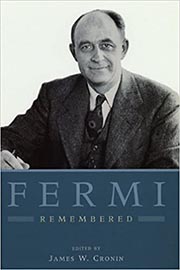Fermi Remembered
by James W. Cronin (Editor)
Reviewed February 18, 2005
 Nobel laureate and scientific luminary Enrico Fermi was a pioneering physicist, best known for his involvement with the Manhattan Project and his work to create the first self-sustained nuclear reaction. Fermi Remembered was created out of a symposium held at the University of Chicago in 2001 to honor the centennial of his birth. This book combines essays and newly written reminiscences alongside private materials from Fermi's personnel files. Contributors of personal reminiscences to Fermi Remembered include seven Nobel laureates in physics.
Nobel laureate and scientific luminary Enrico Fermi was a pioneering physicist, best known for his involvement with the Manhattan Project and his work to create the first self-sustained nuclear reaction. Fermi Remembered was created out of a symposium held at the University of Chicago in 2001 to honor the centennial of his birth. This book combines essays and newly written reminiscences alongside private materials from Fermi's personnel files. Contributors of personal reminiscences to Fermi Remembered include seven Nobel laureates in physics.
The book begins with a brief biographical introduction by Fermi's longtime colleague and biographer, Emilio Segré. The middle portion of the book consists of reproductions of some of Fermi's unpublished notes and correspondence. The last third of the book consists of brief reminiscences by Fermi's former colleagues and students at the University of Chicago.
This work is an enjoyable glimpse into life and work of one of the most famous members of the Los Alamos generation. As one reads this work, you are constantly reminded of the level of greatness that Fermi possessed. During his tenure as professor of physics at the Institute for Nuclear Studies, Fermi attracted an extraordinary scientific faculty and many talented students--ten Nobel Prizes were awarded to faculty or students under his guidance.
One is struck by the fact that unlike nearly all of his colleagues, he was a celebrated experimentalist as well as a theorist, and he continued to move easily between the two types of work right through his last years at Chicago. As a testament to his legacy is the fact that he produced nearly 300 scientific articles during his brief but brilliant career, before losing a battle with stomach cancer.
Emilio Segré summed up Fermi's scientific life in the following words: "He gave to science all he had and with him disappeared the last universal physicist in the tradition of the great men of the 19th century, when it was still possible for a single person to reach the highest summits, both in theory and experiment, and to dominate all fields of physics." This book serves to capture some of the enduring legacy of one the great minds of science.